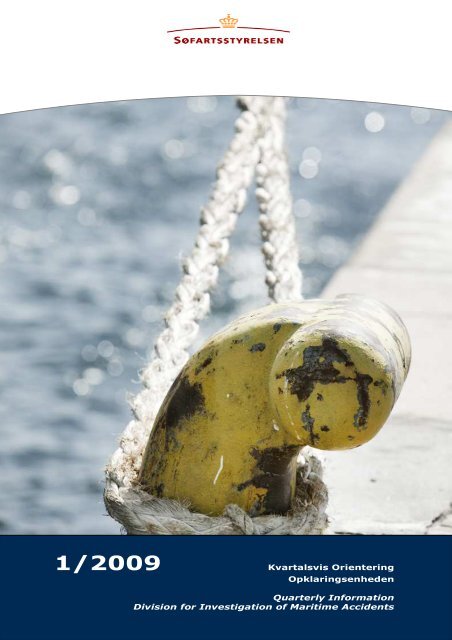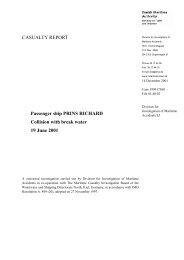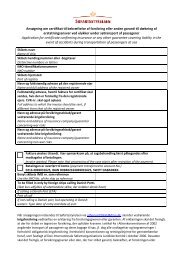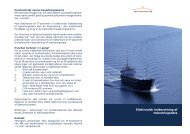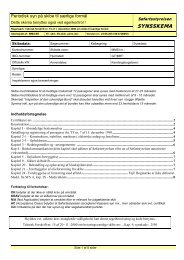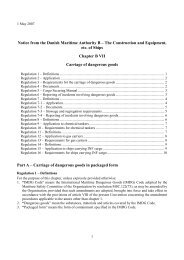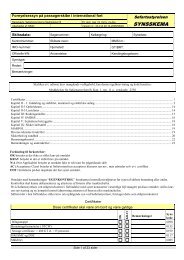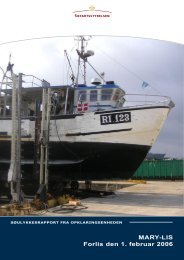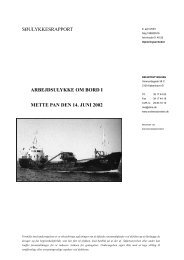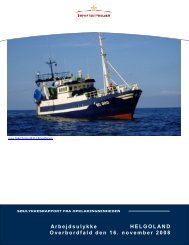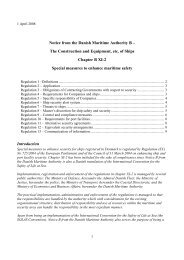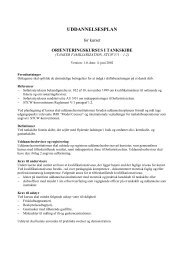kvartalsvis orientering 1 2009 - Søfartsstyrelsen
kvartalsvis orientering 1 2009 - Søfartsstyrelsen
kvartalsvis orientering 1 2009 - Søfartsstyrelsen
You also want an ePaper? Increase the reach of your titles
YUMPU automatically turns print PDFs into web optimized ePapers that Google loves.
REDEGØRELSER fra Opklaringsenheden 3 / 20021/<strong>2009</strong> Kvartalsvis OrienteringOpklaringsenheden1Quarterly InformationDivision for Investigation of Maritime Accidents
Kvartalsvis Orientering 1/<strong>2009</strong>Quaterly Information 1/<strong>2009</strong>IntroduktionPublikationen Kvartalsvis Orientering udgives hvert kvartal for at orientere om deulykker Opklaringsenheden har afsluttet undersøgelsen af. Denne udgave indeholderogså materiale på engelsk.Kvartalsvis Orientering indeholder redegørelser, resuméer af søulykkesrapporter ogtemaundersøgelser, hvis der er udarbejdet sådanne i det pågældende kvartal.En temaundersøgelse er en sammenfatning af en række oplysninger og fakta om enrække ulykker, som Opklaringsenheden har undersøgt, inden for et bestemt område –tema. I Kvartalsvis Orientering kan man læse en introduktion til de/den temaundersøgelse(r),som er udsendt i det pågældende kvartal.Endelig indeholder Kvartalsvis Orientering en kort beskrivelse af en række ulykker,hvor der ikke er udarbejdet søulykkesrapport eller redegørelse. Disse ulykker, der kaldesstatistiksager, er alene indlagt i Opklaringsenhedens ulykkesdatabase og vil indgåsom statistisk materiale i Søfartsstyrelsens årlige publikation ”Ulykker til søs”.Kvartalsvis Orientering, søulykkesrapporter, redegørelser og temaundersøgelserfindes på Søfartsstyrelsens hjemmeside www.sofartsstyrelsen.dk under Ulykkesopklaring.IntroductionThe publication Quarterly Information is published to provide information about theinvestigations of accidents that the Division have completed. Some of the material is inEnglish.The Quarterly Information presents reports (minor), summaries of Marine accidentreports and safety studies.A safety study is a summing up of a number of factual information on several accidentswithin a specific area – a theme. In Quarterly Information, there is an introduction tothe safety studies issued in the quarter in question.The Quarterly Information also presents a short description of a number of accidents,which the Division has not made a report on. The cases are called statistical files. Theinformation gathered in connection with these cases is used for statistical purposesonly. This information is a part of the statistical material in the yearly publication “Accidentsat sea” published by the Danish Maritime Authority.Please find Quarterly Information, Reports and Safety Studies at the Danish MaritimeAuthority’s homepage www.dma.dk under Casualty Investigation.2
Kvartalsvis Orientering 1/<strong>2009</strong>Quaterly Information 1/<strong>2009</strong>Indholdsfortegnelse - ContentsResumé af søulykkesrapporterSummary of Marine Accident ReportsHELGOLAND – Overbordfald den 16. november 2008 5HELGOLAND – Fall overboard on 16 November 2008 6NEW FLAME & TORM GERTRUD – Collision – 12 August 2007.The report is published by Gibraltar as lead investigating state. Theinvestigation was conducted in cooperation with Panama and Denmark.7Redegørelser – ReportsHJARNØ HAVBRUG – Klemning under lugedæksel – 4. december2008Container ship SORØ MÆRSK – Engineer scalded by steam andhot water – 4 November 20081014The grounding of MIRABELLE on 16 December 2008 19Kollision mellem lastskib og fiskeskib den 11. november 2008 22The collision between BLUE BIRD and HAGLAND BONA on 1 st December2008 in Randers Fjord26Kulilte-mik ipingajanneq – Sunseeker 23 Daycruiser – 14. September 332008Kulilteforgiftning – Sunseeker 23 Daycruiser – 14. September 2008 35FRANKVICKI – Kæntring og forlis – 17. December 2008 37Chemical/Products tanker NORD SNOW QUEEN – Accident to seafarer– 14 January <strong>2009</strong>Container ship OLUF MÆRSK – Crewmember injured while handlingCO2 cylinders4145Statistiksager – statistical files 514
Kvartalsvis Orientering 1/<strong>2009</strong>Quaterly Information 1/<strong>2009</strong>Resumé af søulykkesrapporterSummary of Marine Accident ReportsHELGOLAND – Overbordfald den 16. november 2008ResuméHELGOLAND afsejlede fra Thyborøn den 13. november kl. 13.30 for at drive fiskeri iden norske zone af Nordsøen. Der var en besætning på 5 mand om bord.Den 16. november om morgenen satte man voddet ved fly-shooting metoden. Frabakken havde to fiskere fanget bøjelinen med de tre bøjer (gajer) med et dræg, og denene fisker havde fat i bøjelinen og var ved at hive den om bord for at den anden fiskerkunne koble indhaleren til bøjelinen.Da ca. 10 m af bøjelinen var hevet om bord, blev den fisker, som holdt fast i bøjelinen,pludselig hevet udenbords, hen over søgelænderet på bakken. Han fortsatte med atholde fast i bøjelinen, og den anden fisker greb fat i den del af linen, som lå på bakken,og holdt linen stram. Den overbordfaldne fisker slap imidlertid hurtig bøjelinien, menkom herefter ind i en redningskrans, som fra skibet var lagt i søen tæt ved ham. Efter etøjeblik gled han imidlertid igen ud af redningskransen, og det lykkedes ikke de andrefiskere at få ham om bord, før han forsvandt.Der var NV-lig kuling og 5 – 7 m høje bølger.Der blev slået alarm, og den norske redningstjeneste iværksatte hurtigt en eftersøgning.Den overbordfaldne fisker blev imidlertid ikke fundet, og eftersøgningen blev indstilletkl. ca. 17.00.KonklusionOverbordfaldet skyldes, at der opstod et uventet træk i bøjelinen, medens fiskerenholdt fast i linen. Det er ikke muligt med sikkerhed at angive årsagen til dette træk, ellerhvorfor fiskeren ikke gav slip på linen, da trækket opstod. (6.1)Trækket kan være opstået ved en uventet bevægelse af skibet i den høje sø, eller detkan have været ved en pludselig og kraftig påvirkning af bøjerne, eller ved en kombinationaf disse forhold. (6.1)Risiko for overbordfald var ikke erkendt og behandlet før ulykken. (6.2)Der blev ikke anvendt arbejdsvest under arbejdet på dækket, uanset at der var høj sø.(6.2 og 6.4)Der var ikke egnet udstyr til at bjærge en overbordfalden fra et skib med stor dækshøjde,og besætningen var ikke gennem instruktion/drøftelser og øvelser forberedt på denmest effektive metode for bjærgningen. (6.3)5
Kvartalsvis Orientering 1/<strong>2009</strong>Quaterly Information 1/<strong>2009</strong>AnbefalingerDet anbefales HELGOLANDs ejer og reder,• at der udarbejdes risikovurderinger for arbejdsprocesserne om bord i forbindelsemed udsætning og bjærgning af grej, således at de bliver sikre under alleforhold, f.eks. ved at anvende arbejdsveste / livline under arbejde på dækket undervisse vejrforhold og evt. ved at forhøje søgelænderet, samt• at der anskaffes egnet udstyr til bjærgning af en overbordfalden, og at besætningenøves i brug af dette udstyr. I denne forbindelse kan hentes inspiration ipublikationen Rapport om bjergning af overbordfaldne fra fiskeskibe fra FiskerietsArbejdsmiljøråd, se www.f-a.dk under publikationer.HELGOLAND – Fall overboard on 16 November 2008SummaryHELGOLAND sailed from Thyborøn on 13 November at 1330 to fish in the Norwegianzone of the North Sea. There was a 5 men crew on board.In the morning on 16 November the seine was shot using the fly-shooting method.From the forecastle two fishermen caught the buoy-line with the three buoys (gajer)using a grapnel. The one fisherman held the buoy-line and was hauling it on board inorder that the other fisherman could connect the in-hauler to the buoy-line.When approximately 10m of the buoy-line was hauled on board, the fisherman, whoheld the buoy-line, was suddenly pulled over board above the railing on the forecastle.He continued to hold on to the buoy-line, and the other fisherman took hold in the partof the line, which was lying on the forecastle and kept it tight. The fallen overboardfisherman, however, quickly let go the buoy-line, but there after he succeeded in enteringa life buoy, which from the vessel was placed in the sea close to him. Shortly after,however, he again slipped out of the life buoy, and the other fishermen did not succeedto haul him on board before he disappeared.There was a hard breeze from NW and 5 – 7m high waves.Alarm was raised, and the Norwegian salvage service quickly launched a search. Thefisherman fallen overboard was, however, not found, and the search was abandoned atapproximately 1700.ConclusionThe fall overboard was caused by an unexpected drive in the buoy-line, while the fishermanheld the line. It is not possible with certainty to establish the cause to this drive,or why the fisherman did not let go the line, when the drive occurred. (6.1)6
Kvartalsvis Orientering 1/<strong>2009</strong>Quaterly Information 1/<strong>2009</strong>The drive could occur by an unexpected movement of the vessel in the high waves or itcould have been by a sudden and forceful influence of the buoys or by a combinationof the two. (6.1)Then risk of falling over board was not recognised and discussed prior to the accident.(6.2)Lifejacket was not used during work on deck although a high sea. (6.2 and 6.4)The vessel was not equipped to rescue a person fallen over board from a vessel with alarge deck height, and the crew was not prepared trough instruction/dialogue or exercisesin the most effective method of the rescue.RecommendationsThe owner of HELGOLAND is recommended,• to work out risk assessments for the working processes concerning the shootingand the hauling of gear, so thar they are always safe, e.g. by using lifejackets/ lifeline during work on deck under certain weather conditions and possibleby enlargement of the height of railings, and• to procure equipment suitable for rescue of a fallen over board person, and tosee to that the crew is exercised in the use of the equipment. In this respect inspirationcan be found in the pamphlet “Rapport om bjergning af overbordfaldnefra fiskeskibe” (Report on the rescue of fallen over board persons in fishing vessels)from the Danish Fishermen’s Occupational Health Council, look at www.fa.dk, publications.NEW FLAME & TORM GERTRUD – Collision – 12 August2007. The report is published by Gibraltar as leadinvestigating state. The investigation was conducted incooperation with Panama and Denmark.7
Kvartalsvis Orientering 1/<strong>2009</strong>Quaterly Information 1/<strong>2009</strong>8
Kvartalsvis Orientering 1/<strong>2009</strong>Quaterly Information 1/<strong>2009</strong>9
Kvartalsvis Orientering 1/<strong>2009</strong>Quaterly Information 1/<strong>2009</strong>Redegørelser – ReportsRedegørelse fra OpklaringsenhedenHJARNØ HAVBRUGArbejdsulykke, klemning under lugedæksel4. december 2008Lugedæksel over lastrumFoto: OpklaringsenhedenFaktuel informationHJARNØ HAVBRUG er et lastfartøj på 19,7 BT og med en længde på 16,0 meter, deranvendes til at bringe ørreder fra et havbrug i Musholm Bugt til forarbejdning i Reersø.Ørrederne lastes i en brønd, hvori der cirkuleres saltvand. Losningen foregår vedpumpning.Besætningen er på fire mand, der alle er tidligere fiskere.Om formiddagen den 4. december 2008 fik et besætningsmedlem hovedet i klemmemellem lugekarm og lugedæksel. Han nåede at skrige op, hvorved kollegaen, der betjentehåndtaget til lukning af lugen lugen, blev opmærksom på situationen og standsedelugedækslets bevægelse.10
Kvartalsvis Orientering 1/<strong>2009</strong>Quaterly Information 1/<strong>2009</strong>HændelsesforløbHJARNØ HAVBRUG sejlede den 4. december 2008, klokken ca. 02.00, fra Reersø tilhavbruget i Musholm Bugt og hentede dagens første ladning ørreder, ca. 35 tons. Efterudlosning hentede man yderligere en ladning af ca. tilsvarende størrelse og var tilbagei Reersø klokken ca. 09.30.Skipperen åbnede lugen til lastrummet og gjorde i øvrigt klar med diverse slanger ogrør til losningen. Efter 15 – 20 minutters losning kom et besætningsmedlem tilbage ombord med frisk kaffe til næste tur, som han netop havde lavet i land i virksomhedensfrokoststue, og skipperen gik i land for at holde pause.Derefter var der to mand om bord til at losse lasten. De stod i styrbord side og taltesammen, mens de ventede på, at fiskene skulle glide ned til sugestedet i bunden aflasten. De to skiltes. Den ene gik hen agten for lugen, og den anden tog en kost for atskubbe nogle fisk hen ad en rende inden for lugekarmen, hvorefter han gik fremeftermod styrehuset for at lukke lugen. Han havde opfattelsen, at kollegaen var gået agtenom lugen og i land, idet han ikke kunne se ham.Kollegaen var imidlertid ikke gået i land. Han forsøgte med armen at skubbe to fisk nedfra en rist lige inden for lugekarmens agterste side (se billede nedenunder). Han kunnedog ikke umiddelbart nå begge fisk og stak derfor hovedet ind under det delvist åbentståendelugedæksel for bedre at kunne nå den sidste fisk (omtrent som vist på billedetnedenfor). I det samme begyndte lugen at lukke, hvorved han mærkede, at hovedetkom i klemme, og han skreg op. Besætningsmedlemmet ved betjeningshåndtaget hørteskriget, og rent reflektorisk skubbede han håndtaget den modsat vej og standsededermed lukningen.NymonteretsikkerhedsstangFigurant viser den omtrentlige situationFoto: Opklaringsenheden11
Kvartalsvis Orientering 1/<strong>2009</strong>Quaterly Information 1/<strong>2009</strong>Lugedækslet bevægede sig herefter lidt op og i, hvorved besætningsmedlemmet fikhovedet fri og kunne trække det til sig. Han mærkede, at han blødte fra hovedet ogsatte sig på dækket, mens andre straks ilede til hjælp.Besætningsmedlemmet fik førstehjælp og blev med ambulance kørt til Slagelse sygehus,hvor man konstaterede, at han havde fået knubs og sår i panden og i nakken,men i øvrigt var uskadt.Supplerende oplysningerIfølge oplysning fra selskabet var der for år tilbage udarbejdet en arbejdspladsvurderingfor skibet. Denne var imidlertid ikke umiddelbart tilgængelig om bord.Ingen af de to involverede besætningsmedlemmer havde kendskab til nogen arbejdspladsvurdering.Det var ikke aftalt mellem de to besætningsmedlemmer, at den ene skulle forsøge at fåde to fisk ned fra risten.Besætningsmedlemmet, der lukkede lugen, kunne ikke se kollegaen agten for lugen –bl.a. på grund af et stort plastkar, der på det pågældende tidspunkt stod oven på lugen.Besætningsmedlemmet, der ville skubbe de to fisk ned fra risten, vidste ikke, at hanskollega agtede at lukke lugen på det pågældende tidspunkt. Da han tog initiativ til atskubbe til fiskene, var kollegaen ikke placeret ved betjeningshåndtagene til den hydrauliskelukning af lugen.Den tilskadekomne er 39 år, har været fisker i ca. 10 år og har været forhyret i HJAR-NØ HAVBRUG i ca. to måneder, ligesom han også havde et par måneders hyre medskibet i 2007.Besætningsmedlemmet, der lukkede lugen, er 63 år. Han har altid været fisker, og hardesuden de senere år været periodisk forhyret i skibet HJARNØ HAVBRUG.Der er ikke givet nogen konkret instruktion om det specifikke arbejde til besætningsmedlemmerne,da det anses for at være almindeligt forekommende, og det er erfarnefolk, der udfører det.Analyse og konklusionDer blev ikke brugt arbejdspladsvurdering om bord for at klarlægge mulige risikablearbejdsprocesser eller for at tilrettelægge arbejdet sikkerhedsmæssigt forsvarligt.Der var ingen fast procedure for, hvordan man skulle forholde sig for at sikre imod tilskadekomstved lukning af lugen under arbejde med fisken i lasten.Det ene besætningsmedlem vidste ikke, at hans kollega gik hen for at lukke lugen.Det andet besætningsmedlem vidste ikke, at hans kollega gik hen for at skubbe to fiskned fra risten, og han kunne heller ikke se det.12
Kvartalsvis Orientering 1/<strong>2009</strong>Quaterly Information 1/<strong>2009</strong>Det er Opklaringsenhedens opfattelse, at hændelsen skete som følge af mangelfuldkommunikation mellem de to besætningsmedlemmer og manglende planlægning af oguhensigtsmæssig rutine i arbejdet.Det er Opklaringsenhedens opfattelse, at der var dårlige oversigtsforhold fra betjeningsstedetmod det sted, hvorfra besætningsmedlemmet ville fjerne de sidste to fisk.InitiativerStraks efter arbejdsulykken blev der som en umiddelbar og foreløbig foranstaltningmonteret en stang på lugens agterkant, der mekanisk forhindrer lugens lukning, hvisstangen ikke bliver løftet manuelt på stedet.Som en vedvarende foranstaltning til afløsning af ovennævnte stang vil der i forbindelsemed skibets næste værftsophold blive monteret et dobbelt betjeningssystem, dernødvendiggør samtidig påvirkning af betjeningshåndgreb dels ved styrehuset og delspå dækket agten for lugen for at åbne og lukke lugen.AnbefalingerOpklaringsenheden anbefaler, at der udarbejdes en arbejdspladsvurdering for skibet,og at den til enhver tid er kendt og tilgængelig for besætningsmedlemmerne.6. januar <strong>2009</strong>Opklaringsenheden13
Kvartalsvis Orientering 1/<strong>2009</strong>Quaterly Information 1/<strong>2009</strong>Report from the Division for Investigation of Maritime AccidentsContainer ship SORØ MÆRSKAccident to seafarer, engineer scalded bysteam and hot water4 November 2008Factual informationThe shipSORØ MÆRSK is a diesel propelled container ship of 91560 GT with a crew of 25.The accidentOn 4 November 2008, when the ship was on position 28°08’ N – 126°21’ E, navigatingin the Eastern China Sea bound for Yokohama, the 4 th engineer was seriously scaldedwhen he was cleaning a drain pipe. After having received first aid on board the ship hewas taken to hospital by a helicopter from Japan Coast Guard.The engineer4 th engineer is 29 years of age. He is certified as a watch keeping engineer, holding acertificate “RC Engineer Officer” among a long range of other certificates of trainingand skills.14
Kvartalsvis Orientering 1/<strong>2009</strong>Quaterly Information 1/<strong>2009</strong>Picture: Google EarthNarrativeOn 3 November 2008, while making his night round, the 4 th engineer noticed that thedirty water drain from the fuel oil separators was obstructed.The drain, a 2½’’ pipe, was supposed for draining water and oil from four fuel oil separatorsinto a common dirty water tank ventilated to the atmosphere. The drain pipe washeated by steam tracing and furnished with at blind flange for opening and cleaning ofthe pipe as a part of the ship’s design.Next day, he informed 2 nd engineer about the problem and they decided to proceed toclean the draining pipe, a job considered ordinary and not at all dangerous.First, he dismantled the draining cap from separator and saw the pipe was cloggedinside. He poured some diesel oil into the drain, trying to dissolve the sludge but nothinghappened. After that, he tried to poke a wire rope into the pipe, but likewise with noeffectHe tracked the drain pipe and found a visiting flange (blind flange) right under the ceilingin the generator room situated under the fuel oil separator room.15
Kvartalsvis Orientering 1/<strong>2009</strong>Quaterly Information 1/<strong>2009</strong>Photo: chief engineer, m/v SORØ MÆRSK16
Kvartalsvis Orientering 1/<strong>2009</strong>Quaterly Information 1/<strong>2009</strong>Together with the 2 nd engineer, it was decided to dismantle the flange in order to obtaina better position for cleaning the pipe. The 4 th engineer made a draining system from afunnel, a ¾” plastic hose and a 200 litres drum in order not to make mess and proceededdismantling the flange.The 4 th engineer loosened the four bolts of the flange, bit by bit, until nothing came outof the pipe. That slowly draining of the pipe took about 15 minutes.After that, he was able to dismantle completely the flange. I took a look inside theflange and saw that the pipe was almost 90 % clogged from its diameter (the pipe ishorizontal in that position – generator room.After maximum 10 seconds, the sludge inside burst out and hit the engineer all over. Itwas between 1300 and 1330.The engineer was scalded in his face, on his neck, arms, and hands, thighs, forelegs,ankles and feet. He hurried to his cabin to shower and cool the burnt surfaces andclean the skin from oil with soap. At 1405 hours, he called the chief officer for help statinghe was in severe pain due to the scalding/burns.The chief officer hurried to the 4 th engineer’s cabin. On his way he met the master whowas notified about the incident.The 4 th engineer was transferred to the ship’s hospital where he was put in the bath tuband cooling with cold water was continued. The engineer received first aid and treatmentfor his burns and to prevent chock.Radio Medical recommended evacuation, so the injured engineer was taken to hospitalon Okinawa by helicopter from Japan Coast Guard.At 1826, the evacuation was completed and the vessel resumed the voyage to Yokohama.OthersAfter the accident, 2 nd engineer refitted the blind flange on the drain pipe without problems.The pipe was then without pressure.Analysis and conclusionsThe 4 th engineer was hit and scalded by steam, hot water and oil streaming out fromthe pipe after manipulating an obstruction in the pipe with a wire.A steam pressure had obviously been building up in the pipe.It seems like there were two obstructions in the drain pipe, and in the confined spacebetween the obstructions water and oil was heated by the steam tracing, thus creatingsteam pressure.It was not expected that steam pressure could build up inside the pipe, because it wasa drain pipe leading to an open tank.17
Kvartalsvis Orientering 1/<strong>2009</strong>Quaterly Information 1/<strong>2009</strong>Working with the drain pipe was not considered risky at all.On board the ship there was no focus on the risk by working on a steam tracing heatedpipe conveying water.The ship has a work risk assessment (safe job analysis) on computer. However, at thetime of this incident it was not covering work on steam heated pipes.Work risk assessment was not used on board as an active tool for mapping the riskareas in the engine room.InitiativesOn 10 November 2008 an extraordinary safety committee meeting was held on boardto evaluate on the accident in question:The accident area was investigated by the safety committee without finding anydefects.It was stated, that the accident was caused by a blocked drain pipe and pipe underunexpected pressure.All personnel should consider what can go wrong when carrying out certain tasksand bear in mind to be cautious and seek assistance if needed.A safety sign has been made and placed in the accident area.(Abridged by the Investigation Division)Furthermore the shipping company has informed that the risk management procedurehas been changed to incorporate working on piping with heat tracing throughout.Recommendations1. The Investigation Division recommends that the shipping company ensures thatthe work risk assessments on board are used by the relevant crew to map therisk areas in the engine room.2. The Investigation Division recommends the shipping company that the risk assessmentsare being updated and dealt with by the relevant crew members.16 January <strong>2009</strong>The Division for Investigation of Maritime Accidents18
Kvartalsvis Orientering 1/<strong>2009</strong>Quaterly Information 1/<strong>2009</strong>Report from the Division for Investigation of Maritime AccidentsThe grounding of MIRABELLE on 16 December2008Fig. 1. MIRABELLE on ground.Photo by the Investigation DivisionFactual informationMIRABELLE, IMO No 8500070, is a Maltese flag general cargo ship of 3,113 GT. It isNorwegian operated and trading in north European waters.On the 16 December at 1730 local time MIRABELLE grounded at low speed in position55°03.0 N - 010°36.7’ E, shortly after departure from the port of Svendborg.During high water and change of current the vessel re-floated on 18 December at 0225and returned to Svendborg. There was found no damage to the vessel.NarrativeMIRABELLE arrived at Svendborg on 16 December at 0400 with a part load of 900cubic metres of timber from Nakskov. There was a crew of 10 including the master, thechief officer and the 2 nd officer. The three navigators run a 3 shift bridge watch when atsea. In port the chief officer and the 2 nd officer runs a 2 shift watch.The ship arrived at Svendborg via the western entrance of Svendbord Sound. Neitherthe master nor the chief officer had been in Svendborg Sound before. The master,however, was familiar with navigating in Danish waters and other minor harbours, andhe therefore decided not to use a pilot.19
Kvartalsvis Orientering 1/<strong>2009</strong>Quaterly Information 1/<strong>2009</strong>Shortly after arrival the crew started loading more timber. They finished loading at 1700and sailed at 1710 with a full load for Monsteras in Kalmar Sound, Sweden. The forwarddraught was 6.4m and aft draught was 6.45m.During mooring the master was alone on the bridge. The chief officer was on the forecastletogether with two ABs, and the 2 nd officer was on the deck aft together with oneAB.It was calm weather with a good visibility. The ship is equipped with electronic chart,situated close to the manoeuvring desk, and operated with the planned route inserted.Danish paper chart no. 171 with the planned voyage drawn was on the chart table. Theradar was set to 3 miles range, and the echo sounder was switched on. There was noother traffic.With an astern manoeuvre the master came free of the quay and went forward at manoeuvringspeed, about four knots. He was in no doubt with regard to the navigationwest in Svendborg Sound, and he was well aware of the fact that the red buoys shouldbe kept on the starboard side. He manoeuvred the vessel into the Bratten leadinglights. He was steering manual. He did not notice any effect of current.Then he used the search light on top of the bridge roof and operated by a handle justabove the manoeuvring desk. He caught the red buoy on the starboard bow in the light.At about that time the chief officer arrived on the bridge after having finished the mooringand changed cloths. He should take over as the OOW.Shortly after the arrival of the chief officer on the bridge, the master realized, by watchingthe echo sounder that “the bottom came up”. He turned the helm to port, but theship did not react. MIRABELLE was heavily loaded and at a slow speed.Immediately after MIRABELLE grounded approx. 30m north of the red buoy.Fig. 2. Extract of AIS plot from the Danish Maritime Safety Administration20
Kvartalsvis Orientering 1/<strong>2009</strong>Quaterly Information 1/<strong>2009</strong>Analysis and conclusionMIRABELL grounded approximately 15 minutes after departure. The master was aloneon the bridge, because the chief officer, the 2 nd officer and the three ABs were on deckfor the mooring operations. The chief officer came on the bridge shortly before thegrounding.The master was not familiar with the navigation in the area, it was dark and it was anarrow area with a dept of water at places, which was close to the draught of the vessel.He was manoeuvring the ship, he was helmsman, he was navigating in the leadinglights and using the search light to see the dark buoys, which marked the boundaries ofthe fairway.According to the AIS plot MIRABELLE started the turn to starboard approximately300m before the planned turning position. The master can not explain why this happened.He was well rested, and he felt fully confident with the navigation. He did notnotice the early turn on the chart plotter, presumably because he did not watch it.The fact that the master was alone on the bridge and should handle the manoeuvring,the navigation, the look-out and the handling of the search light is the main cause ofthe grounding. He did not notice the starboard turn, before it was too late to avoid thegrounding.In the actual situation, with a full loaded ship in an area with narrow and shallow fairwayswith depth of water nearly the same as the draught of the vessel and in waterwith which the master was not familiar, it would have been an ordinary practice of seamento make use of a local pilot.RecommendationsThe master of MIRABELLE is recommended,to update the ships SMS procedures on watch-keeping to secure that the master isassisted on the bridge during arrivals and departures,to use a pilot in situations like the actual one, where the fully loaded ship shall navigatein a narrow area with shallow water, with which the master is not familiar.22 January <strong>2009</strong>The Division for Investigation of Maritime Accidents21
Kvartalsvis Orientering 1/<strong>2009</strong>Quaterly Information 1/<strong>2009</strong>Redegørelse fra OpklaringsenhedenKollision mellem lastskib og fiskeskib den11. november 2008Lastskibet SAXO af Nørresundby kolliderede med fiskeskibet ANNA PAULSEN fraHanstholm. ANNA PAULSEN fik skader i agterskibet men kunne dog sejle i havn foregen kraft. Der skete ingen skade på SAXO.Faktuel informationSAXO, c/s OZPJ2, IMO nr. 8324672, er et tørlastskib på 1566 BT og en længde på 82m. Det er bygget i Tyskland i 1984, og det opereres af rederiaktieselskabet Saxo i Nørresundby.ANNA POULSEN, HM 136, OU 6727, er en trækutter på 6,8 BT og en længde på 8,5m. Den er bygget i Sverige i 1979, er nu rigget til trawlfiskeri og er privat ejet.Kollisionen skete den 11. november 2008 kl. 14.25 på positionen 57°07,3’ N -008°31,0’ Ø, 2,7 sømil vest for Hanstholm.HændelsesforløbSAXO afsejlede fra Gent den 9. november kl. 14.00 med 1600 tons ”steel coils” modFredrikstad. Der var en besætning på 5 mand. Skibsfører, styrmand og 3 ubefarneskibsassistenter, alle danske statsborgere. Skibsføreren og styrmanden går 6 – 6 vagt istyrehuset.Den 11. november ved middagstid var SAXO på vej nordover langs Jyllands vestkystpå kurs 020° og fart 10 knob. Der var en sydlig vin d, 3 m/sek., en nordgående strøm påca. 1 knob og en sigtbarhed på ca. 5 sømil. Styrmanden havde vagt alene i styrehuset.Kl. 14.15 observerede styrmanden, visuelt og på radaren, et fiskeskib ca. 15° om bagbordi en afstand af 2,4 sømil. Styrmanden skønnede ud fra slæbestregen på radaren,at fiskeskibet, som senere viste sig at være ANNA PAULSEN, ville gå klar om styrbordog passere foran SAXO i en afstand af 0,3 sømil. Styrmanden observerede ikke nogensignaler eller lys, som indikerede, at ANNA PAULSEN var i færd med at fiske. Styrmandenfortsatte derfor på uændret kurs og fart.Kl. 14.25 ramte SAXO trawlgrejet agten for ANNA PAULSEN, hvorved fiskeskibet blevtrukket ind mod SAXO styrbords bov og ramte SAXO. ANNA PAULSEN’s grej brastimidlertid, og fiskeskibet gled ned langs styrbord side af SAXO, indtil de to skibe kom friaf hinanden.SAXO vendte rundt og kom i kontakt med ANNA PAULSEN. Redningsbåden fraHanstholm var hurtig på positionen, og der var ikke behov for yderligere assistance.Fra SAXO blev observeret, at ANNA PAULSEN for egen kraft sejlede mod Hanstholmfulgt af redningsbåden. SAXO genoptog herefter rejsen.22
Kvartalsvis Orientering 1/<strong>2009</strong>Quaterly Information 1/<strong>2009</strong>ANNA PAULSEN sejlede fra Hanstholm den 11. november kl. 06.30 for at fiske medtrawl i det nærtliggende farvand. Fiskeskipperen var, som normalt, alene om bord. Detvar næsten stille og klart vejr med lidt vestlig dønning. ANNA PAULSEN førte trawllysog signalfigur for trawlfiskeri (2 kegler med spidsen mod hinanden), og agter var tændten kraftig halogenlampe.Fiskeskipperen satte grejet og startede med at trawle sydover indtil ca. ud for Klitmøller.Her vendte han og trawlede tilbage mod Hanstholm. Han sad i styrehuset og koncentreredesig om på selvstyreren at styre efter en skrænt på bunden. Radaren stod på3-sømils området. Farten var ca. 2½ knob, og redskaberne rakte ca. 170 favne (ca.310 m) agterud.Kl. 14.25, hvor ANNA PAULSEN slæbte på kurs 066°, b lev fiskeskipperen pludseligslynget rundt i styrehuset, og lidt efter klappede ANNA PAULSEN mod styrbord side afSAXO. Samtidig knækkede trawlwiren, og ANNA PAULSEN kom fri af SAXO. Vedsammenstødet knækkede daviderne, mesanmasten og trawlstativet, og der skete skaderpå skroget agter.Fiskeskipperen havde ikke set SAXO inden kollisionen, hverken på radaren eller visuelt.Der lå to andre kuttere og fiskede 3 – 4 sømil sydvest for ANNA PAULSEN.Fiskeskipperen kontaktede Hanstholm havn, og en redningsbåd fra RedningsstationHanstholm blev sendt ud og fulgte ANNA PAULSEN, som for egen kraft sejlede i havn.Fiskeskipperen havde også kontakt med SAXO, som i første omgang ville sætte MOBbåden i vandet, men redningsbåden var hurtigt fremme, så det blev ikke aktuelt.Analyse og konklusionSAXO’s styrmands observation af ANNA PAULSEN er enten sket tidligere end 10 minutterfør kollisionen, eller afstanden har været mindre end 2,4 sømil. Ellers kunne kollisionenikke have fundet sted med de kurser og farter, som er oplyst, jf. Figur 1.SAXO’s styrmand observerede ingen signaler for fiskeri på ANNA PAULSEN, og hanskønnede ud fra slæbestregen på radaren, at ANNA PAULSEN ville passere foran omSAXO i en afstand af ca. 0,3 sømil. Han holdt derfor kurs og fart.SAXO’s pejling til ANNA PAULSEN var ca. 15° om bagb ord, det vil sige retvisende ca.005°. ANNA PAULSEN sejlede på kurs 066°. SAXO var derfor indhentende skib i forholdtil ANNA PAULSEN og havde som sådan vigepligt overfor ANNA PAULSEN ihenhold til regel 13 i de internationale søvejsregler.SAXO overholdt ikke sin vigepligt i henhold til regel 13.23
Kvartalsvis Orientering 1/<strong>2009</strong>Quaterly Information 1/<strong>2009</strong>Figur 1. Skitse tegnet af OpklaringsenhedenANNA PAULSEN var i færd med at fiske, og fiskeskipperen har oplyst, at kutteren førtefiskelys og fiskesignal. Fiskesignalet var ophængt i kutterens mesanmast.24
Kvartalsvis Orientering 1/<strong>2009</strong>Quaterly Information 1/<strong>2009</strong>Foto taget af Skibsforsikringen i Frede-Figur 2. ANNA PAULSEN efter kollisionen.rikshavn.Ovenstående billede viser, at ANNA PAULSEN førte fiskesignal for trawlfiskeri i mesanmasten.SAXO’s styrmand observerede ikke fiskesignalet, hvilket medførte, at SAXO ikke opfyldtesin vigepligt i henhold til regel 18.Fiskeskipperen havde ikke observeret SAXO inden kollisionen. Han har derfor afskåretsig fra at kunne medvirke til at undgå kollisionen ved afgivelse af det i regel 34 omhandledeopmærksomhedssignal.Kollisionen skyldes hovedsagelig manglende behørig udkig i begge skibe, jf. regel 5 ide internationale søvejsregler.I SAXO medførte det en fejlagtig bedømmelse af passagesituationen samt en manglendeerkendelse af, at fiskeskibet var beskæftiget med fiskeri, og at SAXO derfor havdevigepligt.I ANNA PAULSEN medførte det en manglende observation af SAXO og kollisionsfaren,og dermed tabet af muligheden for at bidrage til at undgå kollision.3. februar <strong>2009</strong>Opklaringsenheden25
Kvartalsvis Orientering 1/<strong>2009</strong>Quaterly Information 1/<strong>2009</strong>Report from the Division for Investigation of Maritime AccidentsThe collision between BLUE BIRD andHAGLAND BONA on 1st December 2008 inRanders Fjord.Factual informationNameBLUE BIRDPort of registryKingstownCall signJ8SK4IMO number 8027391FlagSt.Vincent & The GrenadinesOfficial Number 7282Built 1982TypeGeneral cargo vesselGross tonnage1115 BTClassification societyHellenic RegisterLength overall67.42 mBreadth11.26 mDraught on day of collision 3.22m / 3.82mEngine power1192 kWNumber of crewmembers 8Number of navigators 226
Kvartalsvis Orientering 1/<strong>2009</strong>Quaterly Information 1/<strong>2009</strong>(www.shipspotting.com / © Lars Schmidt)NameHAGLAND BONAPort of registryVallettaCall sign9HYG8IMO number 9132038RegisterMaltaBuilt 1996TypeGeneral cargo vesselGross tonnage2456 BTClassification societyDet Norske VeritasLength overall87.90 mBreadth12.89 mDraught on day of collision 2.20m / 3.50mEngine power1501 kWConstructionDouble bottomNumber of crewmembers 8Number of navigators 2In the following all times are local times (UTC +1 hour).At 2049 on 1 December 2008 HAGLAND BONA (outward bound) and BLUE BIRD (inwardbound) collided in Randers Fjord close to a mutually agreed meeting point. Bothvessels sustained damages to their port bows. In an attempt to avoid the collision,HAGLAND BONA grounded just east of the channel. BLUE BIRD was able to continueto Randers by its own power. HAGLAND BONA was taken afloat in the morning of 2December, and subsequently anchored off Randers Fjord.On the night of the collision the weather was good with a southerly wind 2-3 m/s, goodvisibility and no current.NarrativeBLUE BIRD arrived to a waiting berth in Hundested on 30 November 2008 at 2300waiting to shift to the loading berth. There were no operations during the night. At 0900on 1 December the vessel shifted berth, and the loading was commenced at 0950.27
Kvartalsvis Orientering 1/<strong>2009</strong>Quaterly Information 1/<strong>2009</strong>Loading of 716mt of iron bundles was finished at 1220 and the vessel departed withoutpilot on board at 1240 bound for Randers. BLUE BIRD passed the approach buoy toRanders Fjord at 1927, but did not embark a pilot. During the inbound transit in thedredged channel, the master and chief officer were on the bridge. The master wassteering the vessel using manual hand steering and the chief officer was assisting.HAGLAND BONA departed from Kragerø in Norway 30 November 2008 at 1245 andarrived to Randers 1 December at 0930. Discharging started at 0945 and was completedat 1850. The vessel departed from Randers at 1910 without pilot on boardbound for Herre (Norway) to load timber / logs. From departure until the time of thecollision the master was alone on the bridge.When HAGLAND BONA departed from Randers, the master announced the departureon VHF channels 16 and 12. From a pilot on an outward bound vessel at the entranceto Randers Fjord, HAGLAND BONA was informed of the expected arrival of BLUEBIRD. HAGLAND BONA contacted BLUE BIRD on VHF channel 12, and it becameclear that HAGLAND BONA could not clear the channel before BLUE BIRD had enteredthe channel. The master of HAGLAND BONA therefore recommended that thetwo vessels passed each other port to port at a position due east of Støvringgaard ISOWG.2s 4m (Approximate position of this meeting point is 56° 30’28N / 010° 13’77E –see figure 1). The master of BLUE BIRD agreed to the suggested way of passing andthe passing point.As BLUE BIRD passed Skalmstrup Vig the speed was reduced to below 6 knots as perlocal rules. When approaching the agreed passing point, the master of BLUE BIRDpositioned the vessel as far to starboard in the channel as possible, preparing to passthe other vessel port to port. According to the master of BLUE BIRD he in fact at timeswas out of the channel on its starboard side. When BLUE BIRD was approximately 0.2nm north of the passing point, the vessel was on the western edge of the dredgedchannel.Approximately 15 minutes before the collision, when HAGLAND BONA approached thepassing point from the south, the master of HAGLAND BONA observed that BLUEBIRD would enter the narrow stretch before HAGLAND BONA could clear this narrowpart. The master therefore called BLUE BIRD on VHF requesting this vessel to reducespeed. The master of BLUE BIRD agreed, but HAGLAND BONA did not observe anyreduction in BLUE BIRDs speed. HAGLAND BONA therefore increased his speed inorder to clear the narrow stretch before BLUE BIRD entered. After HAGLAND BONAsincrease in speed, the master of BLUE BIRD plotted HAGLAND BONAs speed to 8.9knots.According to a log-printer on board HAGLAND BONA showing date, time, and ownvessels position, course and speed, the speed at 2036 was 4.4 knots. At 2040 and at2045 the speed was 7.3 knots.According to the master of BLUE BIRD, at 2037 – 12 minutes before collision –he reducedthe speed to 3.2 knots / 320 rpm in order to let HAGLAND BONA clear the narrowpart of the dredged channel.According to AIS-data from the Danish Maritime Safety Administration, at 2046 BLUEBIRDs speed was 5.3 knots.28
Kvartalsvis Orientering 1/<strong>2009</strong>Quaterly Information 1/<strong>2009</strong>Shortly before the end of the narrow stretch, the master of HAGLAND BONA observedthat BLUE BIRD was no longer staying in the western part of the dredged channel, butwas now drifting towards the eastern part. He therefore called BLUE BIRD on VHF,requesting that the vessel returned to the western side of the channel. The master ofBLUE BIRD confirmed that he would return to the west-side of the channel, but fromHAGLAND BONA no change of course was observed.In order to avoid a head-on collision the master of HAGLAND BONA decided to continueon his present heading (which at that time was the heading kept to follow thechannel in the narrows (017°) instead of turning to the course of the next leg of thechannel (001°). At the same time he chose first ‘St op’ and then ‘Full-Astern’ on the engine,but shortly after the vessel ran aground outside the channel in approximate position56° 30’28N / 010° 13’77E.When the collision occurred, HAGLAND BONA had just started to have contact withthe sea floor, and the speed was therefore very low. The two vessels hit each other onboth vessels port bows, and BLUE BIRD slid down the port side of HAGLAND BONA.After the collision the two vessels confirmed that there was no danger for any crew orvessels, and BLUE BIRD therefore continued towards Randers.Other informationAprox. 56°30’28N /010°13’77E:Agreed passing point and eventuallythe position of the collision.Narrow stretch in whichthe two vessels couldnot pass each otherThe channel where the collision took place is a dredged channel, and the assured waterdepth in the channel is 7.0 m. Inward bound the width of the channel from theRanders Fjord entrance to Udbyhøj is 30-50m. For the remaining parts of the channelthe minimum width assured is 22m. According to local pilots the water depth in the partof Randers Fjord where the collision took place decreases rapidly to less than 1.0moutside the channel, causing the sea floor to form a steep subsea slope.29
Kvartalsvis Orientering 1/<strong>2009</strong>Quaterly Information 1/<strong>2009</strong>Fig. 2. – BLUE BIRD on the western edge of the dredged channel.Fig. 3 – BLUE BIRD moving from the western edge towards the middle of the channel.30
Kvartalsvis Orientering 1/<strong>2009</strong>Quaterly Information 1/<strong>2009</strong>Fig. 4. – BLUE BIRD track continuing movement towards the middle. At the time of the collision, BLUEBIRD AIS-antenna seen on the eastern side of the channel.Fig.. 4 – AIS-plot showing the HAGLAND BONA track prior to the collision.31
Kvartalsvis Orientering 1/<strong>2009</strong>Quaterly Information 1/<strong>2009</strong>AIS-data from the Danish Maritime Safety Administration (see fig.4) shows theHAGLAND BONA AIS-track in the eastern part of the channel immediately prior to andthe grounded position following the collision. The shown position of BLUE BIRD in thisplot is not updated, as the BLUE BIRD position in the Danish Maritime Safety Administrationsystem was not updated since 2046. The actual time on the screen-dump onFig.4 is 20:51:06. The BLUE BIRD position shown on this plot is 05 minutes and 07seconds old.The agreed passing point is not the position recommended by local pilots. Vessels witha draught less than 5.50m are recommended to pass each other off ‘Voer anløbsbro’,which is approximately 0.9nm north of the passing position agreed between the twovessels.According to the master of HAGLAND BONA he has previously by a local pilot beenrequested to pass another vessel at this position.ConclusionThe collision between HAGBARD BONA and BLUE BIRD was caused by• The interaction between the sea bed and BLUE BIRD forced the vessel towardsthe middle of the channel. Because of the interaction, it was not possible to returnto the western part of the channel in order to pass HAGLAND BONA port toport in a safe distance.• Due to the water depths outside the channel decreasing rapidly to below 1.0min this area and the fact that the position was in immediate vicinity of a turn inthe channel, the chosen position for passing each other was not the bestchoice.• None of the two vessels had pilot on board. Local pilots would have been ableto choose the best position for passing each other and would have been awareof the risk of interaction between sea bed and the vessels.RecommendationsSince 1998 the Danish Investigation Division has registered a total of 15 groundings inthe Randers Fjord and its approaches. Three of the groundings were with pilot onboard. This indicates an area which is difficult to navigate.• Due to the difficulties when navigating Randers Fjord, the Investigation Divisionrecommends that the Danish Pilot Authority reconsiders the regulation for theuse of Pilots by vessels navigating the Randers Fjord.8 February <strong>2009</strong>The Division for Investigation of Maritime Accidents32
Kvartalsvis Orientering 1/<strong>2009</strong>Quaterly Information 1/<strong>2009</strong>Paasiniaasartut nalunaarutaatKulilte-mik ipingajanneqSunseeker 23 Daycruiser14. september 2008PisimasutInuinnarnit pigineqartoq angallat motorilik ilusimigut taaguutilik ”Sunseeker 23 Daycruiser”tallimanik issimasoqarluni aammalu allamik angallammik motorilimmik kalitaqarluniseptember 2008-mi ulluusoq Nuup Kangerluatigoorluni Nuummut sukkaatsumikingerlaarpoq.Angallat motorilikNanoq ConsultAss: K.S. Nielsen,Ingerlaartillutik issimasut tamarmik ajorsivimmata VHF atorlugu ikiortissarsiortoqarpoqtaamalu annaassiniarneq ingerlanneqalerluni.Angallat alla Nuup Kangerluaniittoq ikiorsiiartorluni orniguppoq tassanngaaniillu inukangallammut motorilimmut ikivoq takuaalu issimasut tamarmik ajorsilluinnarsimasut –taakkunannga pingasut ilisimajunnaareersimallutik. Suli oqalussinnaasortaasa ikiuiniartoqqinnuigaat angallat Nuummukaateqqullugu.33
Kvartalsvis Orientering 1/<strong>2009</strong>Quaterly Information 1/<strong>2009</strong>Nuummi politit annaassiniartartullu piareersimapput napparsimasut napparsimmavimmukaatissallugit.Paasineqarpoq taakku tamarmik kulilte-mik najuussuisimagamik toqunartortortinneqarlutikpeqqarluinnarsimasut.Kulilte-mik ipingajattoqarneranut pissutaavoq angallat sukkaatsumik ingerlatillugu oqqumigaartoqarsimammat.Taamaammat angallatip motoriata benzinatortup eqqarfianiitsullulimmit gas-i umiatsiap uliata iluanut isaalerpoq issimasullu najuussuisilerlugit.KulilteKulilte kemimi allanneqartarpoq CO. Aamma taaneqartarpoq carbonmonoxid, kulmonoxidimaluunniit aamarsuit isserata pujua.Kulilte ersinngitsuuvoq tiperarani aammalu gas-iulluni toqunarluinnartoq, silaannartutoqimaassuseqarpoq najuussuunneqarunilu toqussutaariaannaalluni.Gas-i pinngortarpoq orsussaq ilaannakuusumik ikumagaangat – aammalu motorinibenzinatortuni pinngulertornerusarluni motorini dieselitortuninngarniit.Kulilte anersaartoraangatta iiorartakkatsinnit ilt-imit (O 2 ) 200 – 400-riaammik pilertornerulluniaatta aappalaartortaanut (hæmoglobin-inut) nipputtarpoq, taamalu aatta timitsinnikilt-ilersuinera annikillisipallattarlugu. Taamaammat silaannaq iioragarput annikitsuinnarmilluunniitkulilte-qaraangat inuunermut navianaatilimmik toqunartortortinneqarsinnaavugut.MianersoqqussutUna pisoq qujanartumik ajunngitsumik qaangerneqartoq aallaavigalugu AjutoornernikPaasiniaasartut (Opklaringsenheden) mianersoqqussutigerusuppaat kultilte-mik ipititsisoqarsinnaasoqtoqunartortortitsisoqarsinnaasorlu pingaartumik angallatini benzinatortumikmotorilinni motorip eqqarfianiit sullulimmit gas-i umiatsiap iluanut isaalerluni katersuussinnaammat.Angallat benzinatortumik motoreqarpat ajunnginnerpaasorinarpoq umiatsiami gas-imutsillimaniarluni kalerrisaarutiliisoqarpat, tamakkumi aamma kulilteqalernerani kalerrisaarisarmata.24. februar <strong>2009</strong>Opklaringsenheden - Paasiniaasartut34
Kvartalsvis Orientering 1/<strong>2009</strong>Quaterly Information 1/<strong>2009</strong>Redegørelse fra OpklaringsenhedenKulilteforgiftningSunseeker 23 Daycruiser14. september 2008HændelsesforløbEn privatejet motorbåd af typen ”Sunseeker 23 Daycruiser” med fem personer om bordog en anden motorbåd på slæb var en dag i september 2008 på vej for langsom fart iGodthåbsfjorden mod Nuuk.MotorbådenNanoq ConsultFoto: K.S. Nielsen,Under sejladsen blev alle ombordværende meget syge, og man kaldte hjælp over VHF,hvorefter en redningsoperation blev sat i gang.En anden båd, der var i Godthåbsfjorden, sejlede til undsætning, og en person fra dennebåd gik om bord i motorbåden og fandt alle meget syge – og heraf tre uden bevidsthed.De, der kunne tale, bad hjælperen om at sejle båden ind til Nuuk.I Nuuk stod politi og redningsmandskab parat til at bringe de syge personer til sygehus.Det viste sig, at alle var blevet alvorligt forgiftet af kulilte.35
Kvartalsvis Orientering 1/<strong>2009</strong>Quaterly Information 1/<strong>2009</strong>Kulilteforgiftningen er opstået ved, at båden sejlede langsomt med vinden agterind.Derved er udstødsgas fra bådens benzinmotor trukket ind under kalechen, hvor deombordværende opholdt sig.KulilteKulilte har kemisk betegnelse CO. Den kaldes også carbonmonoxid, kulmonoxid ellerkulos.Kulilten er en klar, lugtløs og meget giftig gasart, der vejer det samme som luft, og somkan dræbe ved indånding.Gassen dannes typisk ved en ufuldstændig forbrænding – og i højere grad i benzinmotorerend i dieselmotorer.Kulilte binder sig 200 – 400 gange lettere til de røde blodlegemer (hæmoglobin) endden ilt (O 2 ), man normalt indånder i atmosfærisk luft, og reducerer blodets evne til attransportere ilt rundt i kroppen. Dermed kan der selv ved en meget beskedenkoncentration af kulilte i luften opstå en livsfarlig forgiftning.AdvarselDenne hændelse, som endte godt, giver Opklaringsenheden anledning til at advaremod kulilteforgiftning, som kan ske, hvor udstødsgas fra især benzinmotorer kan samlesig i bådens indre.Det er en god ide, hvis man har benzinmotor i sin båd, at installere en gasalarm, derogså alarmerer for kulilte.24. februar <strong>2009</strong>Opklaringsenheden36
Kvartalsvis Orientering 1/<strong>2009</strong>Quaterly Information 1/<strong>2009</strong>Redegørelse fra OpklaringsenhedenFRANKVICKIKæntring og forlis17. december 2008Faktuel informationFRANKVICKI på bedding i Stubbekøbing efter forliset.Foto: OpklaringsenhedenFRANKVICKI, ND 109, er et kravelbygget fiskeskib fra 1973. Det er på 6,72 BRT, enlængde på 7,71 m og har et dimensionstal på 22. Fiskeskipperen overtog fartøjet i1979, og han har altid brugt det til bundgarnsfiskeri.17. december kl. 13.30, i Hjelm Bugt, på vej i havn i roligt vej med få fisk i dammen ogca. 200 favne bundgarnsrad på dækket, kæntrede FRANKVICKI på positionen 54°55,3’N - 12°16,1’ Ø. Fartøjet sank i løbet af ca. 15 m inutter. Fiskeskipperen, som var aleneom bord, blev ca. 10 minutter efter reddet af redningsbåden fra redningsstationenKlintholm.FRANKVICKI blev hævet et par dage efter.37
Kvartalsvis Orientering 1/<strong>2009</strong>Quaterly Information 1/<strong>2009</strong>HændelsesforløbFRANKVICKI afsejlede fra Hårbølle den 17. december kl. ca. 08.15 for at røgte garn.Garnene lå på positionen 54°56,4’ N - 12°18,1’ Ø, ca. 1 time 15 min. sejlads fra Hårbøllehavn. Fiskeskipperen var, som normalt, alene om bord. Det var klart og næstenstille vejr. Der var en svag dønning fra syd men ingen sø.Da fartøjet nåede frem til garnene, begyndte fiskeskipperen at tømme ruserne. Der varkun få fisk, et par skrubber og ca. 15 ål. De kom i dammen.Herefter tog fiskeskipperen en bundgarnsrad om bord. Den var ca. 200 favne lang ogfuld af skaller. Den havde stået på positionen siden september måned. Fiskeskipperenovervejede at dele garnraden i to dele, men endte altså med at tage den hele ombord.Fiskeskipperen fordelte garnet jævnt over hele fartøjet, således at det lå på ret køl medet fribord på ca. 15 cm.Herefter, kl. ca. 13.30, påbegyndte fiskeskipperen hjemsejladsen med tomgangsfart,ca. 2 knob, fordi han var klar over, at fartøjet var tungt lastet. Han kunne også mærkepå fartøjets bevægelser, at stabiliteten var dårlig.Kort efter fik FRANKVICKI et ”skvæt vand” ind over styrbord lønning. Det medførte, atfartøjet fik lidt styrbord slagside. For at kompensere for slagsiden, flyttede fiskeskipperengarnet over i bagbord side og øste vandet ud med en pøs.Da vandet i styrbord side var øst over bord, og med garnet flyttet over til bagbord, fikfartøjet bagbord slagside. FRANKVICKI var på dette tidspunkt på en sydvestlig kurs,langs med kysten af Møn, og havde den svage dønning ind på bagbord bov.Efter en sejlads på ca. 2 sømil fik fartøjet sø ind over bagbord lønning, hvilket bevirkede,at det krængede yderligere til bagbord. Herved gled noget af garnet udenbords,hvilket øgede slagsiden.Fiskeskipperen stillede skruen i neutral, og fartøjet stoppede. Han tog redningskransenfra styrehustaget og udsendte MAYDAY på VHF, kanal 16. Lyngby Radio (LYRA) svaredestraks, og fiskeskipperen opgav sin omtrentlige position. LYRA meddelte, at derville blive sendt en helikopter, som ville være fremme i løbet af 20-30 minutter. Hereftergik radioen død.Der skyllede flere dønninger ind over fartøjets bagbords lønning, og det bevirkede, atFRANKVICKI kæntrede i løbet af 20-30 sekunder. Det lagde sig på bagbord side ogbegyndte at synke med agterenden. Fiskeskipperen tog redningskransen over hovedetog svømmede hen til fartøjets stævn, hvor han kravlede op og stillede sig på den spilkop,som er monteret i stævnen.Her stod han i 10-15 minutter, medens fartøjet sank mere og mere. Da stævnen komunder vand, svømmede fiskeskipperen hen til garnet, som flød på vandet ca. 5 m fraden synkende båd. Han kravlede op på garnkuglerne og gled herved ud af redningskransen.Garnkuglerne holdt ham oppe, indtil redningsbåden fra Klintholm ca. 10 minuttersenere bjærgede ham om bord.38
Kvartalsvis Orientering 1/<strong>2009</strong>Quaterly Information 1/<strong>2009</strong>Fra redningsbåden blev han løftet op i en helikopter og fløjet til Rigshospitalet. Hanblev udskrevet samme dags aften.En sandsuger hævede FRANKVICKI to dage senere og bragte det til Stubbekøbing.Bundgarnsfartøjet FRANKVICKIFRANKVICHI’s dæk og dam Lænserist til dam Foto: OpklaringsenhedenFRANKVICKI er bygget i 1973 på Stubbekøbing Bådebyggeri. Det er et kravelbyggettræfartøj på 6,72 BRT, en længe overalt på 7,71 m og med et dimensionstal (lgd. xbrd.) på 22. Fartøjet er under dækket indrettet med motorrum agter. Foran for dette endam med to adskilte rum og herefter et stuverum. I damtragten er indsat en afløbsristfra dæk til dam i hver side. Der er ikke lænseporte i skanseklædningen. Skibet er udstyretmed VHF. Der er en håndpumpe i motorrummet og en håndpumpe i stuverummeti forskibet. Der er ikke vandstandsalarm, og der er ikke selvstyrer.Fiskeskipperen er 65 år. Han har fisket med bundgarn siden 1969 og ejet FRANKVICKIsiden 1979. Han har ikke nogen teoretisk fiskeuddannelse.Han fisker normalt alene. Normalt har fiskeskipperen en jolle på slæb, når han sejler udfor at sætte eller bjærge garn, men ikke hvis han kun skal røgte ruserne. På den omhandledetur var slæbejollen ikke med.RedningsudstyrFRANKVICKI var udstyret med en redningskrans på styrehustaget og en redningsvest,som var placeret i stuverummet i forskibet. Der var hverken redningsflåde eller redningsdragtom bord.Analyse og konklusion39
Kvartalsvis Orientering 1/<strong>2009</strong>Quaterly Information 1/<strong>2009</strong>FRANKVICKI fik et lavt fribord, da de 200 favne garn blev taget om bord. Fartøjet fikherved en dårlig stabilitet. Fiskeskipperen var klar over dette og sejlede derfor hjemadmed laveste fart.Da FRANKVICKI fik sø indenbords, og garnet skred, kæntrede fartøjet hurtigt. Bl.a.fordi vandet ikke kunne løbe af dækket, fordi der ikke var lænseporte i skanseklædningen.Herefter trængte vand efterhånden ned i fartøjet, så det sank.FRANKVICKI havde hverken den foreskrevne redningsflåde eller den foreskrevne redningsdragtom bord.Fiskeskipperen nåede imidlertid at slå alarm på VHF, kanal 16, og da redningsbådenfra Klintholm var tæt på, blev han reddet.25. februar <strong>2009</strong>Opklaringsenheden40
Kvartalsvis Orientering 1/<strong>2009</strong>Quaterly Information 1/<strong>2009</strong>Report from the Division for Investigation of Maritime AccidentsChemical/Products tankerNORD SNOW QUEENAccident to seafarer, 14 January <strong>2009</strong>Factual informationThe shipNORD SNOW QUEEN, IMO No. 9376828, is a chemical tanker of 24.066 GT and alength of 183.00 metres over all, built in 2008.Sister ship of NORD SNOW QUEENPhoto: Dampskibsselskabet NORDEN A/SThe accidentOn 14 January <strong>2009</strong> whilst the ship was operating in the Mediterranean, the chief officerwas on his way to the paint shop in the forecastle. When passing on a catwalk hehit his head against a stringer whereby he suffered severe bruise to his forehead. Thechief officer fainted and fell on the deck which caused a broken arm and injury to hisspine.The chief officerThe chief officer is 45 years of age and 183 cm of height. He is holding a master’s certificateand has approx. 13 years of experience in the merchant marine and before thatapprox. 12 years in fishing. He was newly employed by this company and had been onboard for 10 days.41
Kvartalsvis Orientering 1/<strong>2009</strong>Quaterly Information 1/<strong>2009</strong>NarrativeThe following in this chapter is based on statements from the chief officer, the masterand the shipping company and on minutes from the extraordinary safety committeemeeting, held on board on 16 January <strong>2009</strong>:On 14 January <strong>2009</strong> before noon, while the tanker NORD SNOW QUEEN was enroute from Gibraltar to Malta, an ordinary safety committee meeting was held.At the meeting it was suggested that warning posters regarding ventilation in the paintshop was moved in order to avoid the poster not being visible when the door to thepaint shop was open. It was decided that this was to be carried out immediately.After noon, the chief officer went to the paint shop below the forecastle to see how theposter could be moved to a more visible position.StringerPassagewayHose on decknot presentView to the forecastle and the place of the accidentPhoto: D.S. Norden A/SOn his way to the paint shop, when passing on a catwalk on the starboard entry belowthe forecastle, he hit his head against a stringer, and due to the heavy impact he wasknocked out and fell down unconscious. He was not wearing a protective helmet.After a short while, the chief officer regained consciousness and was sitting on the catwalkfor a moment before he went to the bridge, where he knew the master was. Hecould feel on the right side of his brow and on the left arm that that he was badly hurt.On the bridge the chief officer was placed in the bridge couch while the master waschecking his pulse and blood pressure etc. The chief officer had sustained concussionof the brain and a fracture of his left arm.The officer was tested for alcohol, on his own initiative. The test showed no alcohol.Radio Medical, Denmark, was consulted and advised that the chief officer was taken tohospital ashore.The ship deviated from its original route and headed for Sicily.During the afternoon the chief officer’s breathing stopped five times, and each time itwas regained by the use of a resuscitator.42
Kvartalsvis Orientering 1/<strong>2009</strong>Quaterly Information 1/<strong>2009</strong>JRCC Denmark contacted JRCC Roma that, in cooperation with JRCC Cagliari, arrangedthe evacuation and transportation by launch of the injured chief officer to a hospitalsouth of Cagliari, Sardinia.Subsequently, after he was hospitalized, it was ascertained that the chief officer alsosustained injury to his spine/back. This was not noted on board, even though he hadbeen moved around e.g. returning from the forecastle, during treatment where he wasmoved into sitting position etc., because he had severe pain from the other injuries.The catwalk and the lower stringerThe catwalk is made of gratings approx. 25 cm above deck level. Where the catwalk,just abaft the forecastle, is turning from transverse to longitudinal there is a yellowpainted lower stringer one has to step over when passing into the paint shop.The height from the grating to the top of the lower stringer is 20 cm on one side and 23cm on the other side.The upper stringerWhere the catwalk is turning from transverse to longitudinal there is a stringer belowthe forecastle.The height from the grating to this stringer is 165 cm at the lowest side increasing to186 cm at the highest side.The stringer was painted in yellow and black stripes.Weather conditionsAt the time of the accident there was north-westerly wind 10 m/sec., wave heightapprox. 2.5 m, air temperature approx. 12° C, good visibility and daylight.The ship was steady in the sea, and the deck was dry with no slippery spots.Protective helmetIt is standard company procedures and instructions that protective helmet is worn at alltime during work on deck.Analysis and conclusionsThe height between the catwalk grating and the upper stringer is 165 cm increasing to186 cm.The upper stringer was painted in yellow and black stripes, but not covered by any softand protective material.Where the catwalk turns from transverse to longitudinal there is a lower, yellow painted,stringer one has to step over.The chief officer hit the upper stringer because this was situated over a catwalk in arelatively low height.43
Kvartalsvis Orientering 1/<strong>2009</strong>Quaterly Information 1/<strong>2009</strong>The lower stringer may have drawn the attention of the chief officer passing on thecatwalk and thus prevent him from becoming aware of the upper stringer.The chief officer did not wear a protective helmet.This may have contributed to the severity of the incidents.Initiatives and recommendationsAt an extraordinary safety committee meeting on 16 January, it was decided that a riskassessment for walking on deck was to be made.Furthermore it was suggested to apply rubber protection pads to sharp corners on lowhanging stringers and all yellow markings and yellow/black warning stripes to be renewedwhere necessary. This conclusion has been distributed to the fleet of sisterships as well as to the site office.A new railing is planned to be erected on the catwalk near the stringer to slow downpersons’ passing to the paint shop.The Investigation Division recommends the shipping company:• to emphasize to all seafarers employed by the company the importance ofwearing a protective helmet as stated in the company’s own instructions and• to implement considered/planned alterations of the railing arrangement at thecatwalk to ensure the safe passage beneath the stringer on this ship and on sisterships as well.4 March <strong>2009</strong>The Division for Investigation of Maritime Accidents44
Kvartalsvis Orientering 1/<strong>2009</strong>Quaterly Information 1/<strong>2009</strong>Report from the Division for Investigation of Maritime AccidentsContainer ship OLUF MÆRSKAccident to seafarer, 5 January <strong>2009</strong>,Crew member injured while handling CO 2 -cylindersFactual informationThe shipOLUF MÆRSK is a container ship of 34,202 GT and a length over all of 247 metresand with a crew of 20.The accidentWhen placing CO 2 -cylinders in racks on the deck, one cylinder, that had not been secured,tilted and hit a crew member who was squatting on the deck right beside therack. The crew member sustained severe injuries to his head and was taken to hospital.The crew memberThe injured crew member is 24 years of age. He is qualified in advanced fire fighting,proficiency in survival craft, ratings performing of navigational watch and basic safetytraining. He signed on the ship as an Ordinary Seaman (OS) on 12 December 2008.NarrativeThe following in this chapter is based on statements from the master, the chief officerand the able bodied seaman (AB) who was participating in the stowage of CO 2 -cylinders:OLUF MÆRSK arrived in San Antonio, Chile, on 5 January <strong>2009</strong> at 0650, and the shipwas scheduled to depart from this port on the same day at 2100.At every call in San Antonio empty CO 2 and oxygen cylinders are exchanged for rechargedones. These gases are used en route for controlling the atmosphere in reefercontainers. The exchange of cylinders is normally carried out by the ship’s crew, butdepending of the number of cylinders, the local Maersk Reefer employees will assist.45
Kvartalsvis Orientering 1/<strong>2009</strong>Quaterly Information 1/<strong>2009</strong>The cylinders’ placement on the main deck aft of the accommodationPhoto: The ship’s master35 cylinders are placed in transverse racks on the main deck aft of the accommodationon the starboard side as shown on the picture. The rest of the cylinders are to bestowed directly on deck and lashed to the coaming of the aftermost hold.At this call at San Antonio, apart from the normal cargo operation, the ship was to loadsome 130 cylinders with pressurized CO 2 and oxygen, each weighing approximately 90kg. Assistance would be given from the Maersk Reefer employees.The instructions from the chief officer to the crew were to do this job, however to prioritizeprovision when arriving. He had planned the work hours for the deck crew so therewere at least three persons on deck at a time, of these minimum two being experiencedcrew members, AB and/or bosun.At approx. 1730, the chief officer noticed that the loading of CO 2 cylinders was in process,and at approx. 1840 he noticed that the bosun was resting and an AB and an OSwere handling cylinders, still assisted by local Maersk Reefer employees.The AB had joined the team on deck at 1800 as he relived the bosun. He operated thecrane and helped securing the CO 2 cylinders in the rack.The cylinders were loaded by means of a cargo net from ashore and landed on deckright behind the accommodation. The cylinders were thus landed in a horizontal position,from where they were pushed along deck towards the storage rack.46
Kvartalsvis Orientering 1/<strong>2009</strong>Quaterly Information 1/<strong>2009</strong>A crew member in the same position as in the situation of the accidentPhoto by the ship’s masterThe bottom of CO 2 cylinders, not firmly standing in the racksPhoto by the ship’s master47
Kvartalsvis Orientering 1/<strong>2009</strong>Quaterly Information 1/<strong>2009</strong>When placing the CO 2 cylinders in the racks, each cylinder was lying in a horizontalposition, and a piece of wood was placed at the end of each rack. Then each CO 2 cylinderwas canted with the bottom onto the piece of wood to work them onto the level ofthe racks in order to shift them into the rack lane.The AB was holding the cylinder on top while the OS was squatting on the deck holdingat the bottom helping to push the cylinder to reach the rack lane. Suddenly at 1935,one cylinder already placed in the rack but not yet secured, fell over and hit the OSwho was squatting on the deck. He was hit and contused at his head.The AB raised the cylinder and secured it with a rope and ran to call the chief officer.The chief officer arrived at the scene of the accident immediately when called. Hefound the OS lying on deck next to the racks.The OS was conscious but shocked and bleeding from his head and face. Two of thelocal Maersk Reefer employees were with him. The chief officer asked one of them tocall an ambulance whereupon he called the master himself and fetched the bandagebox to give first aid to the injured OS.At 1947, an ambulance arrived and further treatment to the injured OS was done bystaff from the ambulance. At 2000 he was disembarked on a stretcher by the ship’sstores crane and brought to hospital. Medical examinations revealed that he sustainedcontusion/heavy bruising in his right face orbit, close to the eye, but no fractures.Securing of the CO 2 cylindersAt the time of the accident four CO 2 cylinders had already been stowed in the rack butnot secured. When standing in the stowage rack the CO 2 cylinders get very little supportand can easily tilt, when the vessel is listing during cargo operation.Protective helmetsThe crew members were wearing protective helmets during the work with the CO 2 cylinders.Planning and instructionAccording to the master’s report this was a standard task carried out at every call atSan Antonio. Thus no specific planning of the work was made except that minimum twopersons, one of which had to be AB or bosun, were needed for the job.The ship is holding a risk assessment named “SJA” for Safe Job Analysis. At the timeof the accident no SJA was laid down related to the handling of CO 2 and oxygen cylinders.Work hoursThe OS was doing day work, and within 24 hours prior to the accident he had workedfor 11 hours.Safety committee meetingOn 6 January <strong>2009</strong>, the day after the accident, an extraordinary safety committeemeeting was held on board. The agenda for this meeting was solely to discuss this48
Kvartalsvis Orientering 1/<strong>2009</strong>Quaterly Information 1/<strong>2009</strong>accident. Various suggestions as to how an accident like this could be prevented weregiven, and it was agreed that locking pins should be made to be placed on the upperpart of the racks in holes already there, thus preventing CO 2 cylinders from capsizingduring stowage. Furthermore it was agreed that it is inappropriate that the bottom supporton the racks are elevated 9 cm from deck level and thereby making it necessary tolift the cylinders from deck. The work space is confined and stowage of the cylindersshould be as easy and safe as possible. Further investigations will be made to as howthis issue can be solved.Corrective actionsAs an immediate corrective action locking pins were made to be inserted step by stepwhen stowing cylinders in racks.After the accident a Safe Job Analysis (SJA) for this job was laid down. The SJA containspossible hazard effects, consequences, descriptions and responsibilities.The shipping company also conducted an internal investigation in order to find causes,establish lessons to be learned and recommendations to prevent recurrence. That reportwill be sent to the ships and parties of relevance.Analysis and conclusionsThe rack gave no transverse support to the cylinders if not secured.When placed in the racks and not yet secured the cylinders could easily tilt because oftransverse movements of the ship during loading operations.At the time of the accident four cylinders standing in the rack were not yet secured.The CO 2 cylinder tilted because of movement of the ship and because it was not yetsecured.The cylinders needed to be lifted 9 cm from deck and guided into the rack to bestowed.A crew member was squatting on the deck beside the rack engaged in stowing cylindersin the rack.The crew member was hit and injured by the falling CO 2 cylinder.A crew member squatting on the deck just beside the cylinder racks is in a very vulnerablesituation and rather exposed to be hit by a tilting cylinder.No Safe Job Analysis was laid down for this specific task, even though a large amountof CO 2 and oxygen cylinders used to be exchanged at each call of San Antonio.No specific instructions were given to the crew members regarding this task except thatat least two persons were needed one of which had to be an AB or bosun.The work was not planned and organised to ensure safe working conditions.49
Kvartalsvis Orientering 1/<strong>2009</strong>Quaterly Information 1/<strong>2009</strong>The cylinders were not secured one by one because no instruction to do so was given.RecommendationsThe Investigation Division recommends the shipping company to investigate how tohandle and store large amounts of CO 2 and oxygen cylinders in a more safe and easyway.The investigation Division recommends the shipping company to make the Safe JobAnalysis that has been worked out for this ship after the accident valid for other shipshanding gas cylinders in a similar way.16 March <strong>2009</strong>The Division for Investigation of Maritime Accidents50
Kvartalsvis Orientering 1/<strong>2009</strong>Quaterly Information 1/<strong>2009</strong>Statistiksager 1. kvartal <strong>2009</strong>Statistical files 1 th quarter <strong>2009</strong>SkibstypeHigh Speed Ro-Ro PassagerskibFiskefartøjFiskefartøjHændelse idetaljerKort beskrivelse af ulykkenHårdtvejrsskade En dansk hurtigfærge bliver under rejse i åbent farvand ramtaf en forkert sø, hvorved skibet bremses mærkbart. Da detforsøges at åbne bovport kan denne ikke åbnes. Årsagenopgivet sin en mindre skævhed i en hydraulisk låsecylinder.Ved inspektion i havn blev opdaget indtrykninger af klædningi forskibet samt nogle bøjede 'knæ' indenbords. Skibet blevtilbageholdt indtil skader var repareret.Grundstødning På forlægning fra Dragør til Rødby havn sejlede fiskeskibetpå grund ved Henæs havn, hvor skipperen ville hvile nattenover.Grundstødning På vej ind til Hvide Sande grundstødte et 20 BT stort fiskeskib.Renden var stedvis tilsandet og sandpumperen var ikkefærdig med uddybning. Fiskeskibet kom hurtig flot ved egenhjælp og fortsatte i havn. Der blev ikke konstateret skader.Passagerskib Andet Kort før anløb af Ystad blev det konstateret, at en rude ibistroen var krakkeleret. Ruden blev slået ud af besætningenog det viste sig senere at vinduesrammen i alluminium varrevnet. Nærmere undersøgelser viste at revnen var en udløberaf en tidligere observeret revne, som var sprunget opigen.Olietankskib Kontaktskade Under tillægning til oliepieren i Guldhavn med lods om bordkom manøvren ud af kontrol, hvilket bevirkede, at et 21329BT udenlandsk tankskib i ballast ramte et hjørne af pierenmed stor kraft. Skibet fik et ½ m2 stort hul til en ballasttank ibagbord side ca. 2½ m over vandlininen.StykgodsskibGrundstødning Et mindre udenlandsk tørlastskib under anløb af havn mistedestyringen på grund af lav fart og lægt vand ifht. Dybgang.Skibet kom derfor ud af den snævre gravede rende, og løbpå grund. Skibet kunne dagen efter slæbes af grunden medkun mindre skader.Kemikalietankskib Grundstødning Et udenlandsk tankskib med lods om bord gik med lav fartpå grund på vej ind til Frederikshavn. Der var hård sydligkuling og ca. ½ m lavvande. Grundstødningen skete på dennordlige kant af sejlrenden. Skibets kom flot ved egen hjælpved stigende vande ca. 2 timer senere og fortsatte i havn.Der var ingen skader og ingen forurening.Passagerskib Kontaktskade Under ankomst til Rostock svigtede kontrollen til pitchpropellerne,hvorved skibet bliver umanøvredygtigt og efterfølgendetørner kajen. Årsagen er ikke blevet fundet.Bugserbåd Havari Under bugsering af pram ud for Spaniens NV kyst i dårligtvejr sprang slæbewiren fra en bugserbåd på 282 GT. Trodsbistand fra helikopter og resque båd lykkedes det ikke atgenetablere slæbet, og prammen, som var lastet med bygningsmaskineri,drev på grund.Containerskib Arbejdsulykke Under et dansk containerskibs passage af Biscayen i vind aforkanstyrke, faldt et besætningsmedlem på broen under en51
Kvartalsvis Orientering 1/<strong>2009</strong>Quaterly Information 1/<strong>2009</strong>SkibstypeStykgodsskibHændelse idetaljerKemikalietankskib ArbejdsulykkeKort beskrivelse af ulykkenkrængning på omkring 45 grader. Han kurede fra den eneende af broen til den anden og fik herunder mindre skader ihovedet og på overkroppen.Grundstødning Et dansk lastskib på 1449 BT grundstødte i norsk fjord idagslys og fint vejr. Føreren var alene på broen. Han varoptaget af lastepapirer og drejede for sent ved en bøje. Skibetblev trukket flot ca. 11 time senere og sejlede til kaj. Derblev ikke konstateret skader på skibet.Under tilrigning af lodslejder for afsætning af lods i rute T udfor Skagen fra et udenlandsk tankskib på 24066 BT faldt enmatros i vandet og forsvandt. Skibet satte sin MOB båd ivandet. Den kæntrede, og de tre ombordværende endte ivandet. De blev samlet op og fløjet til hospital i land. To afdem blev kort efter udskrevet.Fritidsfartøj Andet En 20 årig mand afsejlede i stille vejr kl. ca. 15. Da han ikkevar kommet tilbage efter mørkets frembud, tog en makker udfor at søge efter ham. Båden blev fundet tom og et par timersenere blev manden fundet drivende i vandoverfladen. Gashåndtagetvar brækket.Uddybningsfartøj KontaktskadeEt uddybningsfartøj på på 188 bt og 29,2 meter i længde varpå vej til at anløbe Lynetten i Københavns Havn, hvor skibsførerenunder manøvre forsøgte gentagne gange at slå bakpå begge maskiner. Hovedmotoren ville ikke slå bak. Derblev derfor slået fuld baj på den bagbord hovedmotor for atstoppe fremdriften i skibet. Skibet tørnede kajen frontalt medca. 1,5 knobs fart. Efter gentagne manøvrer lykkedes det atfå den styrbord hovedmotor i neutral hvorefter skibet medmanøvre på kun den bagbord. hovedmotor kom til kaj. Årsagentil manøvreproblemerne var fpr lavt hydraulisk tryk iomstyringsanlægget.Containerskib Kontaktskade Under anduvning af Nuuk havn mistede skibet kontrollenmed propelleromstyringen og sejlede ind i kajhammeren.Der skete ingen personskade, men skibet fik slået et størrehul i stævnen ind til forepeak tanken.Sandpumper Havari Under sandsugning blev flere stykker uekspoderet ammunitionsuget om bord i skibet. En granat eksploderede i skibetsSB sandpumpe, hvilket resulterede i at pumpen flækkede oglækkede vand in pumperummet. Lækagen blev hurtigt afspærretved hjælp af ventiler. Ingen kom til skade ved ulykken.Ingen forurening.Stykgodsskib Arbejdsulykke Et mindre dansk fragtskib var på vej nordover i farvandet udfor NV Frankrig i dårligt vejr med høje bølger. Under en kraftigoverhaling mistedede styrmanden, som netop var kommetpå broen for afløsning, balancen og rutchede fra denene side af broen til den anden. Hans venstre for blev slemtskadet, og skibet sejlede til Brest, hvor styrmanden kom påhospital.SandpumperGrundstødning En dansk sandsuger på vej til Middelfart nord fra grundstødtenordøst for havnen, fordi strømmen overraskede denvagthavende navigatør. Skibet blev trukket flot ca. 10 timersenere. Ingen skader.Stykgodsskib Kontaktskade Ved anløb til Port Moroni, ramte skibet en uafmærket under-52
Kvartalsvis Orientering 1/<strong>2009</strong>Quaterly Information 1/<strong>2009</strong>SkibstypeLodsbådSandpumper ellerstenfiskerSandpumper ellerstenfiskerHændelse idetaljerKort beskrivelse af ulykkenvandshindring i sejlløbet ind til havnen. Det var sandsynligvisfundamentet til en søafmærkning, der ikke længere var synlig.Der var lods om bord, men denne oplyste ikke om undervandshindringen.Grundstødning Efter at have sat en lods af i det sydlige Lillebælt sejledebådføreren alene tilbage mod Fredericia. Lige syd for Fænøfaldt han i søvn og båden sejlede med 29 knob op på stranden.KontaktskadeKontaktskadeEn mindre udenlandsk sandsuger/stenfisker kolliderede undersejlads i gravet snæver rende med en pram, der varopankret for uddybningsarbejder i renden. En jolle fortøjetlangs den opankrede pram blev knust. Ellers kun små skaderpå både sandsuger og pram. Sandsugeren kunne fortsættehavneanløbet for egen maskine,og efterfølgende forsejletil værft for reparation af stålskader i skanseklædningog på bak.Et dansk entreprenørfartøj under arbejde i udenlandsk havnsejlede under havnemanøvre over sit eget anker, hvorvedundervandsskroget beskadiges. Der opstod lækage, og ca.200 liter diesel strømmer ud i havnen. Skibet gik til lokaltværft for repararioner.Supplyskib Kontaktskade Under havnemanøvre sprang flexkabel til omstyring af propeller.Skibet sejlede ind i kajen, fortsatte videre og ramte etandet skib, hvis trosser sprang. Situationen kom hurtigt underkontrol og der skete kun materiel skade.OlietankskibGrundstødning Under sejlads i Nordsøen, blev der ikke ændret kurs rettidigttil sejlads gennem Slugen. Denne fejl blev erkendt 5 minutterfør grundstødningen, men efterfølgende kursændring varikke tilstrækkelig til at undgå grundstødning.Fishing vessel Collision During transit to the fishing grounds, a Swedish fishing- vesselcollides with an UK registered wooden angling vessel,that was also in transit. The Swedish vessel was overtakingthe UK vessel, but the duty officer of the fishing vessel didnot observe the other vessel prior to the collision. The collisioncaused severe damages to the wheelhouse, the superstructureand the hull of the wooden vessel. The Swedishfishing vessel only suffered minor damages to the paintworkof the bow. The UK vessel lost steering as a result of thecollision, and was towed back to harbour by the Swedishvessel.53


